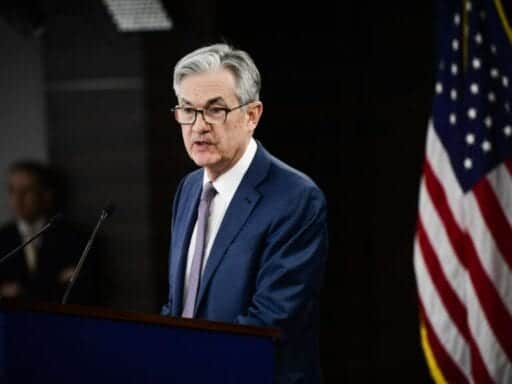Interest rates are now at zero, just like in the 2008 financial crisis.
The Federal Reserve announced on Sunday, March 15 that it would cut its target interest rate to a range of 0 to 0.25 percent, returning interest rates to the record lows they reached during the 2008-09 recession and its aftermath.
The move represented the clearest sign yet that the Fed considers the coronavirus outbreak a severe economic risk that could slow the economy and possibly cause a large recession.
“The Committee expects to maintain this target range until it is confident that the economy has weathered recent events and is on track to achieve its maximum employment and price stability goals,” the Federal Reserve said in a statement.
The Fed funds rate (often colloquially called the “Fed rate” or even just the “interest rate,” given its economy-wide effects) is the primary mechanism through which the Fed influences the American economy. When the Fed uses its powers to lower the rate, that means borrowing is cheaper: Mortgage rates fall, APRs for credit cards fall, auto loans get cheaper, etc. This is meant to stimulate economic activity by making it cheaper to borrow and spend. The Fed enforces this target both through expectations (it’s powerful enough that just saying “we’re lowering rates” causes banks and other actors to follow suit) and through “open market operations,” in which it buys up Treasury bonds with money it creates in a bid to make those bonds’ interest rates fall to its target range. For more, see Matt Yglesias’s explainer.
You can see the historical trajectory of the Fed rate over the past two decades, including during the last recession, below:
/cdn.vox-cdn.com/uploads/chorus_asset/file/19808332/fredgraph.png) Federal Reserve Bank of St. Louis
Federal Reserve Bank of St. LouisAs you can see, the rate tends to rise during economic expansions, when the Fed uses it to control inflation and prevent the economy from “overheating,” and falls during downturns in an effort to stanch the bleeding. The previous Fed chair, Janet Yellen, began a process of raising interest rates during her tenure in an attempt to “normalize” them after they fell to historic lows under her predecessor Ben Bernanke, to try to fight the Great Recession.
Many economists faulted Yellen and her deputy, Stanley Fischer, for raising rates too soon when the labor market was still recovering, and there was still space to reduce unemployment, especially as inflation has been at historic lows, meaning there’s little downside to low interest rates. Usually the only downside to low rates has been the risk of inflation, as occurred in the mid- to late 1970s, but that hasn’t been a reality in the US for several decades now.
Jay Powell, the current Fed chair, took the unorthodox step of slashing rates during an economic expansion on the logic that the labor market could be doing even better. This likely reduced unemployment and has not had any ill effects on inflation.
But Powell and the Federal Open Markets Committee have slashed rates even more dramatically since the coronavirus presented a risk of recession. On March 3, the board slashed rates from a 1.5 to 1.75 percent range to 1 to 1.25 percent, a half-point cut. The latest cut is twice as big in scale: a full point reduction down to a range of 0 to 0.25 percent.
This places the Fed at what economists call the “zero lower bound”: Because interest rates are at zero, there is a limit to how much lower they can go. The Fed is not powerless at the zero lower bound. The European Central Bank has been experimenting with modestly negative interest rates since June 2014, and the Bank of Japan has since January 2016.
Under a negative rate system, investors have to actually pay borrowers to take their money. But the ECB rate is only -0.5 percent, a very small cost to most depositors. If rates get too negative, there’s a risk that businesses and individuals will start pulling their money from banks entirely and holding cash; if your checking account is losing, say, 5 percent of its value a year, there’s a good case for taking your money out and stuffing it under a mattress.
In extreme cases like that, the Fed has other tools. In the aftermath of the Great Recession, it engaged in “quantitative easing,” where it injected trillions into the economy by buying long-run Treasury bonds and mortgage-backed investments in an effort to bring down long-run interest rates, as well as the short-run interest rates impacted by the Fed rate. But long-run interest rates are already negative or very, very low for US Treasury bonds, so it’s not clear how much quantitative easing could do right now.
In this scenario, there’s a strong case for fiscal stimulus: spending by Congress to get the economy up and running again. There’s a strong humanitarian case as well, as people employed in service industries like restaurants, bars, gyms, etc. could be out of work indefinitely and lack funds to buy basic necessities. For this reason, many prominent economists on the left and right are begging Congress to authorize large cash payments to at least low-income Americans.
Author: Dylan Matthews
Read More



